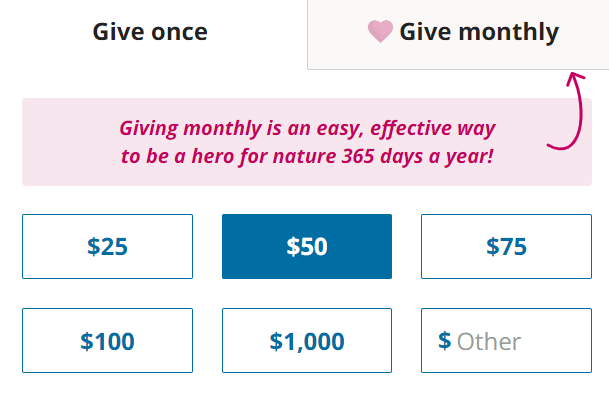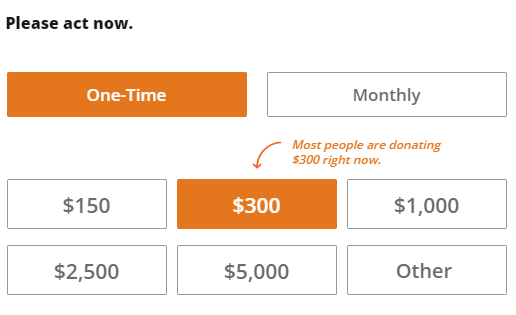
The past couple of years have represented a challenging time for nonprofit fundraising. Individual giving declined in 2022, and 70% of nonprofits expect giving to continue to decrease or remain flat.
In difficult circumstances, it’s helpful to return to the fundraising basics to ensure you’re making the most of tried and true strategies to boost your nonprofit’s donation revenue. This guide will review these tips for bringing in more donations:
- Prioritize building strong supporter relationships.
- Explain the impact of donations.
- Enable recurring donations.
- Offer suggested giving amounts.
- Streamline your online donation form.
- Go above and beyond to show appreciation.
As you incorporate these tips, work at fostering genuine supporter relationships, and strategize ways to improve the donor experience, you can generate more reliable revenue streams over time.
1. Prioritize building strong supporter relationships.
Boosting revenue starts with forming stronger ties with the people who support your mission: your donors.
Generic communications like mass emails sent to everyone in your organization’s donor database do little to form meaningful connections. Instead, show supporters that you care about them as individuals by adding these strategies to your email marketing approach:
- Create donor segments. Use the donor data in your nonprofit’s constituent relationship management system (CRM) to segment donors into groups based on shared characteristics and preferences. For example, you can create groups based on supporters’ giving habits, such as donation recency, type, amount, frequency, and reason for donating. Then, draft marketing materials tailored to the needs and interests of each group to create a more personalized experience. For instance, in-kind donors might want to know how you’re using their gifts to run your programs, while monetary donors would be interested in hearing how you’re using financial donations to further your mission.
- Personalize donor outreach. Always address donors by their name, rather than a generic greeting like “Dear Donor” or “To Whom It May Concern.” Leverage fundraising software tools and marketing platforms that automatically populate your email subject lines and greetings with donors’ names stored in your CRM.
- Foster face-to-face connections when possible. When you have the chance to connect with supporters in person, take it! Before events, review your list of RSVPs (especially major donor prospects) who will attend so that you can plan to talk with them. Or, set up meetings with supporters to get to know them better. Show donors you’re invested in getting to know them personally by asking questions about their hobbies, families, professions, and connections to your nonprofit’s mission.
Building relationships with all of your supporters can strengthen your donor retention rate and help your nonprofit raise more funds over time. Plus, it’s essential for cultivating your major gift program, helping you take the necessary steps to secure significant donations.
To make personalization as simple as possible, leverage an online giving platform integrated with your CRM. This ensures seamless data transfers between the platforms, providing access to accurate information like the spelling of donors’ names or their giving histories.
2. Explain the impact of donations.
75% of donors who give regularly seek information about the nonprofit’s impact. Donors want to know about the issues your organization strives to address, the projects and programs you pursue to achieve your mission, how you use donations, your organization’s growth over time, and more.
Use blog posts or fundraising landing pages to highlight the positive impact that donations have on your ability to achieve your mission. Demonstrate the impact of donors’ gifts using multimedia content such as:
- Interviews with beneficiaries, staff members, board members, and volunteers
- Statistics that reveal the impact of your projects and programs on your community or cause
- Photos and videos that show your mission in action, such as volunteers helping community members or beneficiaries achieving their goals with your nonprofit’s help
Above all, your fundraising message should keep donors and beneficiaries at the center, not your nonprofit itself. For example, compare the impact of the following statements:
“Because of our nonprofit’s tireless efforts, we were able to provide 100 laptops for local students interested in pursuing computer science careers.”
Vs.
“Donors’ tireless support and the generosity of our local community helped get 100 laptops into the hands of local students interested in pursuing computer science careers.”
As you can see, just a few subtle wording changes turn a nonprofit-centric statement into a supporter-centric one.
3. Enable recurring donations.
Recurring donations, such as monthly gifts, help foster a reliable giving stream for your nonprofit, providing more stability amid any declines in other fundraising avenues. For instance, the end of the year is a lucrative time for most organizations, while the summer months typically yield a giving lull. Monthly donations ensure your organization has consistent funding no matter the season.
Plus, retaining your recurring donors can greatly boost the value they bring to your nonprofit over the years. Research shows that a 10% improvement in your donor retention can lead to an up to 200% increase in donors’ lifetime value.
Offer a recurring giving option on your online donation page. Allow donors to turn a one-time gift into a recurring donation with just the click of a button. For example, check out how the World Wildlife Fund online donation page enables simple monthly donations:

Make sure this option is present on all giving forms, including your main online giving page as well as any peer-to-peer fundraising pages your supporters create on your behalf.
4. Offer suggested giving amounts.
Suggested giving amounts are buttons on your donation page that allow donors to choose a pre-offered gift amount rather than stressing over how much to give. Suggested donations help speed up the giving process and give donors a clear idea of the type of gifts your nonprofit expects to receive, encouraging them to align with the norm.
Bloomerang’s donation page guide recommends following these guidelines to make the most of your donation suggestions:
- Use your average donation amount to choose suggestions. Set your lowest suggested giving amount as your median donation size to encourage larger gifts. For example, if your median donation amount is $150, you could provide suggestions of $150, $300, $500, and $1,000.
- Leverage A/B testing. In this context, A/B testing is the process of testing different gift suggestions to see which options yield the highest donation amounts. Experiment with different suggested giving ranges to understand which options appeal to your donors the most.
- Describe the impact of giving at different levels. For example, you could let donors know that “$100 helps provide a week of meals to a family in need, $500 can help the family for a month, and $1,200 can support the family for a full year.” This helps turn abstract donation amounts into the real impact that donors can have.
You can also use social proof to encourage donors to choose a certain giving amount. For example, take a look at how the CARE online donation page highlights their $300 donation amount with a note that says “Most people are giving $300 right now.”

5. Streamline your online donation form.
A lengthy donation form could discourage supporters from giving. By simplifying and streamlining your donation page as much as possible, you can decrease form abandonment and boost conversions.
Keep supporters on the page by:
- Reducing unnecessary questions. It’s tempting to try to collect lots of information about your supporters during the donation process, such as their demographics or interests. However, asking too many questions increases the chances that supporters will abandon your page. Instead, try asking supporters to complete a survey after they’ve hit “submit.”
- Choosing images strategically. Choose just one image to include on the page to avoid distracting supporters while still providing an opportunity for emotional connection. Be sure to compress the image to support faster page load speeds.
- Ensuring your calls to action (CTAs) stand out. Your donation page’s most important CTA is the final “donate” or “submit” button. Make this button stand out by using bold fonts and strongly contrasting colors. You can also reassure donors that they’re giving their intended amount by automatically including each donor’s gift amount within the submit button. For example, the CTA might say “Donate $55 Now.”
Donors often have busy schedules, so by making your donation page as straightforward as possible, you show respect for their time and encourage them to complete the full form.
6. Go above and beyond to show appreciation.
Around 13% of donors say that the reason they stopped giving to an organization was that the nonprofit didn’t acknowledge their support. By going above and beyond to show your appreciation, you can stay top of mind for your supporters and encourage them to stay involved.
Make your gratitude clear by:
- Calling donors to say thank you
- Sending free merchandise, such as t-shirts or water bottles
- Hosting appreciation events, such as trivia nights or free concerts
- Asking for feedback using a donor satisfaction survey
- Creating appreciation videos with messages from volunteers, beneficiaries, and your nonprofit’s leaders
Donors drive your mission forward, and these appreciation ideas help you take that extra step to make supporters feel truly valued.
The Bottom Line
Nonprofits focused on growth often worry about what their next big fundraiser will be or how they can pack their schedule full of opportunities for supporters to give back. However, many organizations often overlook the major impact that simple donor stewardship and donation page optimization efforts can have in increasing donation revenue.
Keep these tips in mind when you need to take your fundraising approach back to basics and ensure your nonprofit has a strong foundation to meet current and future challenges.
About the Author
 Jay Love, Co-Founder and current Chief Relationship Officer at Bloomerang has served this sector for 33 years and is considered the most well-known senior statesman whose advice is sought constantly.
Jay Love, Co-Founder and current Chief Relationship Officer at Bloomerang has served this sector for 33 years and is considered the most well-known senior statesman whose advice is sought constantly.
Prior to Bloomerang, he was the CEO and Co-Founder of eTapestry for 11 years, which at the time was the leading SaaS technology company serving the charity sector. Jay and his team grew the company to more than 10,000 nonprofit clients, charting a decade of record growth.
He is a graduate of Butler University with a B.S. in Business Administration. Over the years, he has given more than 2,500 speeches around the world for the charity sector and is often the voice of new technology for fundraisers.






Leave A Comment